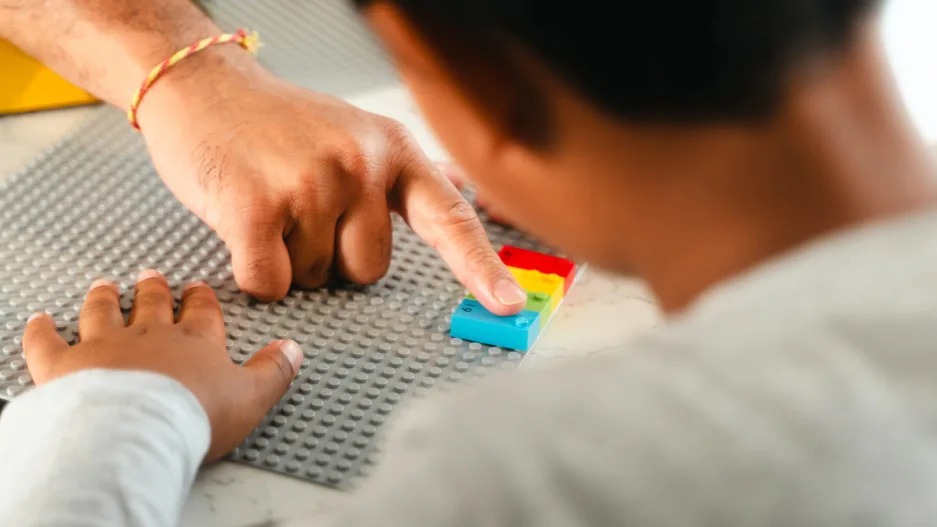- | 8:00 am
The newest Lego set is designed to teach kids Braille
The bumps on each brick spell out the letters and numbers of the Braille alphabet.

When Amit Patel lost his sight because of an illness a decade ago—early in his career as a trauma doctor at an emergency room in the U.K.—he struggled to learn Braille with traditional tools. He hacked together a system with ping-pong balls that he rearranged in an egg carton to form the shape of letters as he studied. Now, his young children, who are sighted but want to learn Braille to bond with their dad, have another option: A new Lego set that spells out the Braille alphabet with the dots on each brick.

Before the “Braille Bricks” existed, when his 4-year-old and 7-year-old sat down to try to learn Braille, “they would get bored,” says Patel, whose family is one of the first to try out the new product. “Then, when the Lego bricks came along, it’s play and learn all at once. And we can do it as a family.”
A few years ago, the Lego Foundation developed Braille bricks that were given to teachers in schools for visually impaired children. After Lego got feedback from families saying that they wanted to be able to use the bricks separately—in some cases, because children attend mainstream schools and have limited or no access to Braille lessons—the company started working on another version for the home.

“We set up some few design principles: It has to be something that was easy for everybody to learn, and it has to be fun,” says Lego designer Rasmus Løgstrup. “It has to connect the family. Everybody has to be on an equal level, so it’s as inclusive as possible. And we made a product that you can keep continuing building, and not just kind of sit on the shelf and only be used once.”
The physical design of the bricks is the same as the version used in schools, with the “studs” on the top of each block representing a Braille letter or number. But Lego designers spent more than a year designing games that can make it fun to use the bricks even before a child starts to recognize specific letters.

In one game, for example, one player pretends to be a sleeping giant, and the others use bricks with three or more studs to build a wall to protect their village without waking the giant up. Players can listen to short videos describing each game on a smartphone via a QR code on the package. “We had a starting point that we would like these games to be fully functional even when you’re blind and you’re on your own,” says Løgstrup. “So, no help by a sighted person.” After setting up a game, the short video encourages open play. In Patel’s family, his children quickly started using the blocks to create signs for their Lego village that their dad could read.
The designers spent months learning about their newest customers. “We started asking ourselves, with a visually impaired kid, how do they play? What is the dynamic at home in the family? What are their challenges?” Løgstrup says. The set is designed for children and families with a range of visual impairments; because some players will have limited vision but some sight, the blocks come in brightly contrasted colors, and the illustration on the box was designed to make it more legible. The company worked with organizations for the blind around the world to test the product.

The number of visually impaired people who learn Braille keeps dropping. In the U.S., for example, fewer than 10% of people who are legally blind are literate in Braille. “My computer can speak to me, so in theory, I don’t have to use Braille,” says Martine Abel-Williamson, president of the World Blind Union. But she still uses it herself constantly, and believes it’s a critical tool and important to learn. Patel agrees.
“I used to love coming home from work and just immersing myself in a book,” he says. “People tell me, ‘Well, you don’t need to learn Braille because of assistive technology out there—screen readers, audiobooks—but that really doesn’t do it for me. If someone’s reading a book to me, I’ve got their tone of voice, I’ve got the way they get excited about something on my page. I like to read something and maybe go back and read it again.” There are other practical reasons that it’s sometimes easier to quickly read with your fingers rather than listening to something, whether you’re on a subway or ordering from a menu at a restaurant.
And playing with Lego blocks, he says, is just a fun way to learn the alphabet. He liked using the toys with his children even before they had access to the Braille Bricks. “Despite being visually impaired, you can still lose yourself in Lego,” he says. “It’s a whole brain activity, where, in a weird way, you don’t need sight to play. Your imagination kind of kicks in. It’s all touch, it’s all feel. It’s a satisfying click when things come together.”
The set, which costs $89.99, will be available for sale in English and French versions on September 1, with preorders beginning today.






































